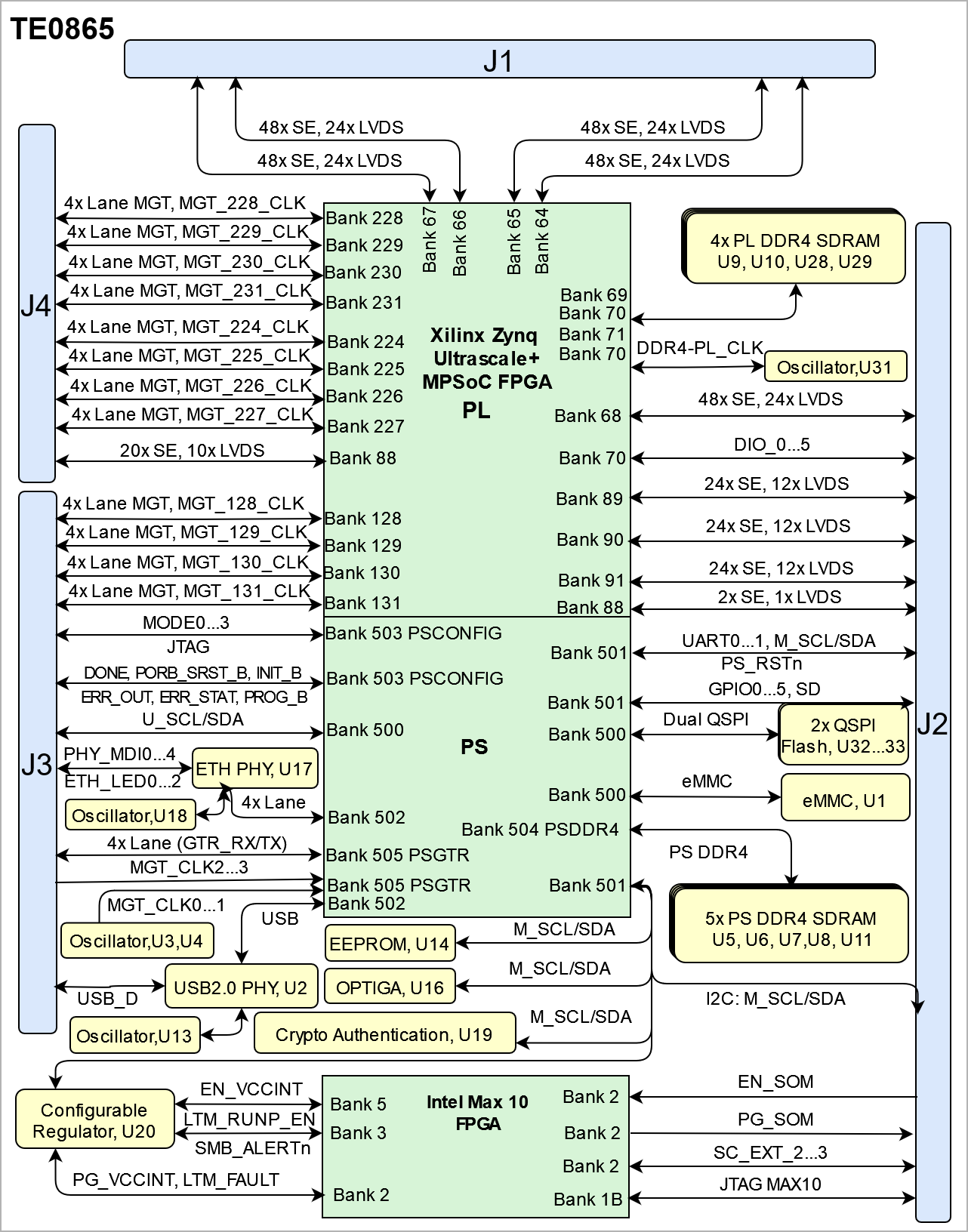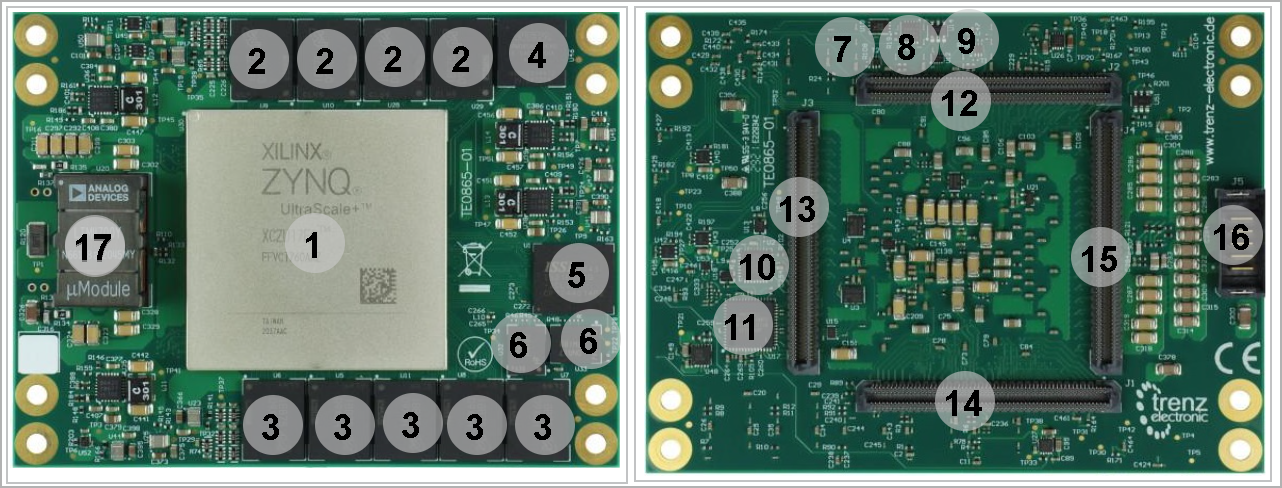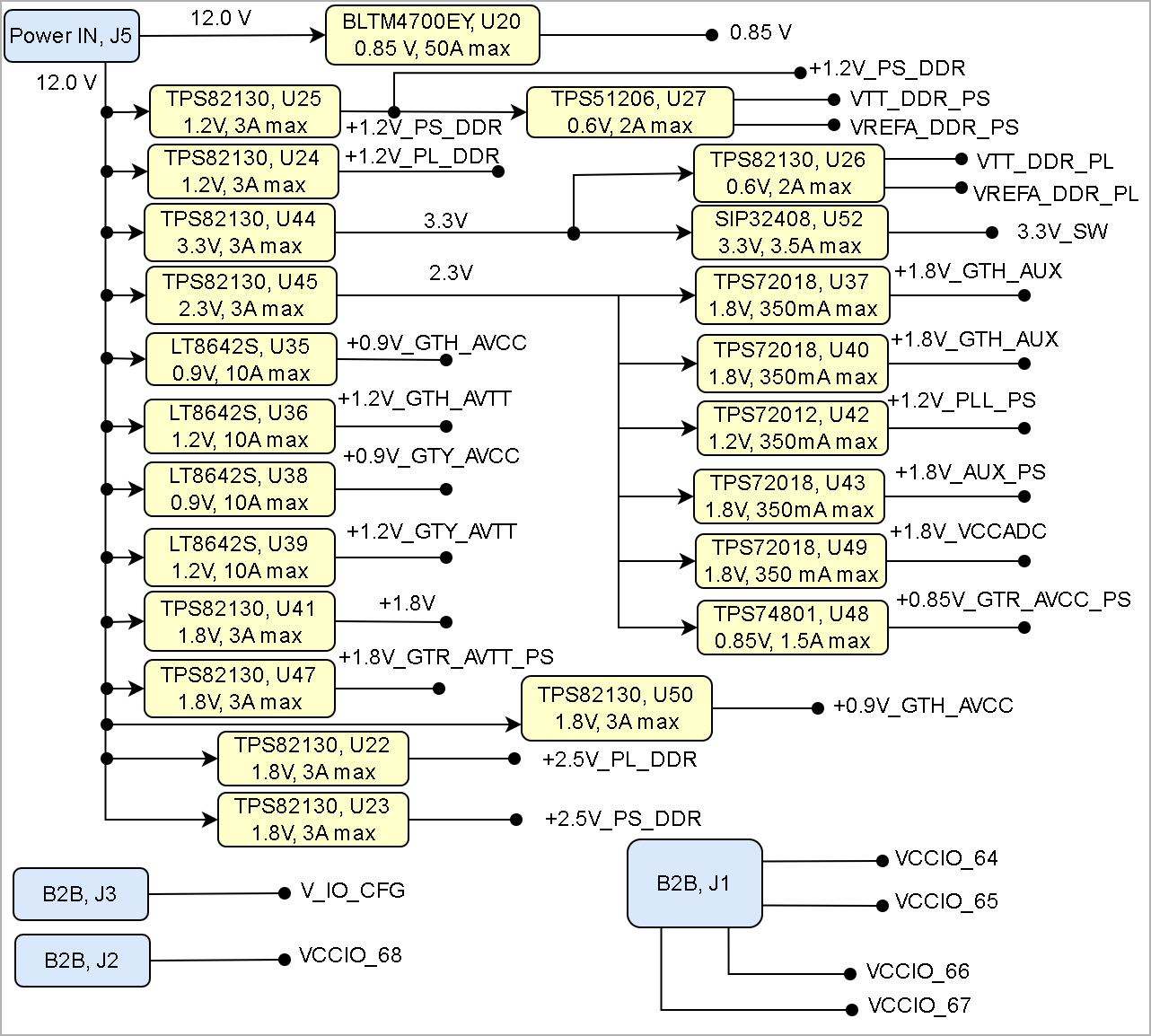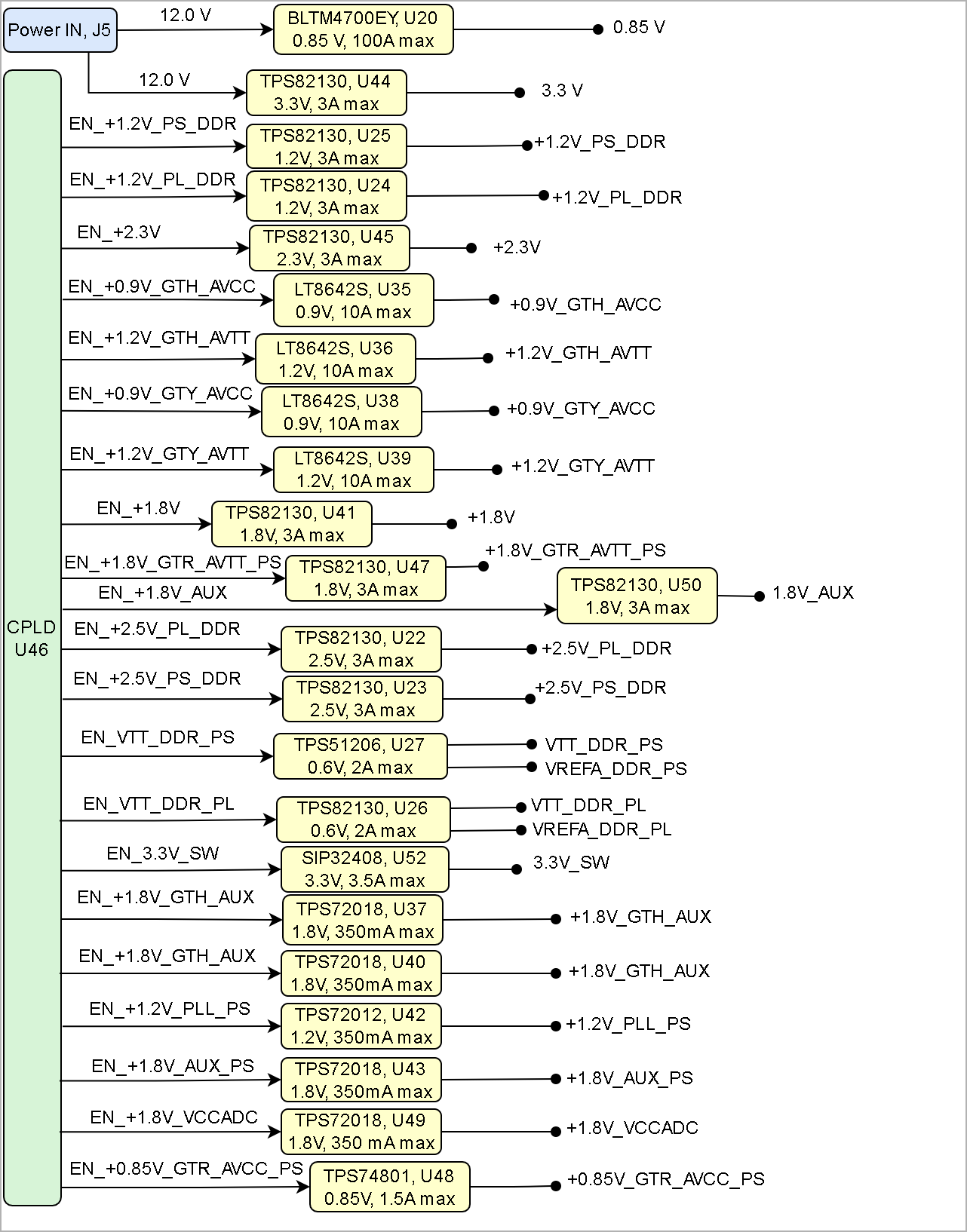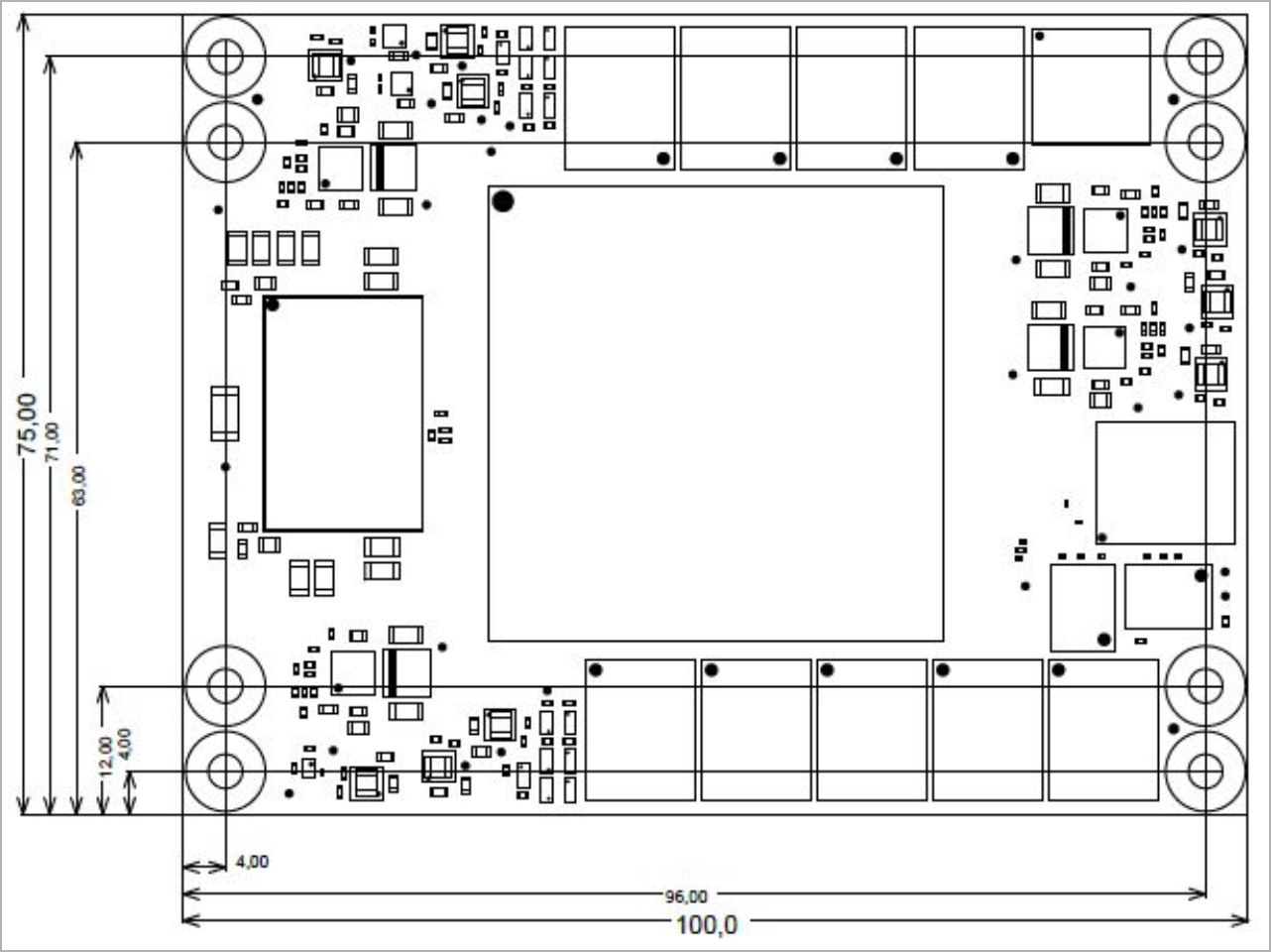
Template Revision 3.1
- Module: TRM Name always "TE Series Name" +TRM
Example: "TE0728 TRM"
Template Change history: Template Change history: - 3.02 to 3.1
- New general notes for temperature range to "Recommended Operating Conditions"
- 3.01 to 3.02
- add again fix table of content with workaround to use it for pdf and wiki
- Export Link for key features examples
- Notes for different Types (with and without Main FPGA)
- Export Link for Signals, Interfaces and Pins examples
- Notes for different Types (Modul, Modul Hypride, Evalboard, Carrier)
- 3.0 to 3.01
- remove fix table of content and page layout ( split page layout make trouble with pdf export)
- changed and add note to signal and interfaces, to on board periphery section
- ...(not finished)
- 2.13 to 3.00
- → separation of Carrier/Module and evaluation kit TRM
- 2.14 to 2.15
- add excerpt macro to key features
- 2.13 to 2.14
- add fix table of content
- add table size as macro
|
----------------------------------------------------------------------- |
Note for Download Link of the Scroll ignore macro: |
Overview
The Trenz Electronic TE0865 is an industrial/extended grade module based on Xilinx Zunq UltraScale+ MPSoC. The TE0865 is equipped with 4x 2GB DDR4 SDRAM connected to Programmable Logic(PL) and 5x 2GB DDR4 SDRAM connected to Processing System(PS), 8 GB eMMC, 2x 64MB Quad SPI Flash, Gigabit Ethernet Transceiver, USB Transceiver, Ultra micro power terminal and an Intel MAx 10 as system controller CPLD.
Refer to http://trenz.org/te0865-info for the current online version of this manual and other available documentation.
Key Features
- SoC/FPGA
- Package: C1760
- Device: ZU11, ZU17, ZU19*
- Engine: EG*
- Speed: -1, -2,*, **
- Temperature: I, E,*, **
- RAM/Storage
- Low Power DDR4 on PS
- Data width: 16bit
- Size: def. 2GB*
- Speed: 3200 (MT/s) ***
- Low Power DDR4 on PL
- Data width: 16bit
- Size: def. 2GB*
- Speed:***
- eMMC
- Data width: 8Bit
- size: def. 8GB *
- Dual QSPI boot Flash in dual parallel mode (size depends on assembly version)
- Data width: 8bit
- size: def. 64MB *
- MAC address serial EEPROM with EUI-48™ node identity (Microchip 24AA025E48)
- On Board
- Intel Max 10 as CPLD
- 6x MEMS Oscillator
- Gigabit Ethernet transceiver PHY (Marvell Alaska 88E1512)
- Hi-speed USB2 ULPI transceiver with full OTG support (Microchip USB3340C)
- Interface
- 214 x PS I/Os
- 96x HD I/Os
- 416x HP I/Os
- 4x PS GTR
- 3x Samtec Accelerate HD B2B connector
- 78x MIOs
- Power
- 12V input supply voltage
- Variable Bank IO Power Input
- Dimension
- Notes
- * depends on assembly version
- ** also non low power assembly options possible
- *** depends on used U+ Zynq and DDR4 combination
|
Block Diagram
add drawIO object in Scroll Ignore section and add reference image in Scroll Only.
Title (not anchor) of all Scroll Title such as DrawIOs and Tables should be changed according to the Module name. Example: TE0812 Block Diagram |
All created DrawIOs should be named according to the Module name: Example: DrawIO of TE0812 Block Diagram should be named TE0812_OV_BD |
|
Main Components
Notes : - Picture of the PCB (top and bottom side) with labels of important components
- Add List below
|
- ZYNQ Ultrascale+ MPSoC FPGA, U30
- PL DDR4 SDRAM, U9, U10, U28, U29
- PS DDR4 SDRAM, U5...U8, U11
- Intel MAX 10 FPGA, U46
- eMMC RAM, U1
- Dual QSPI Flash, U32, U33
- Crypto Authentication IC, U19
- OPTIGA Trust M Authentication IC, U16
- EEPROM MAC Address, U14
- USB2.0 Transceiver, U2
- Gigabit Ethernet Transceiver, U17
- B2B Connector, J2
- B2B Connector, J3
- B2B Connector, J1
- B2B Connector, J4
- Power Terminal, J5
Initial Delivery State
Only components like EEPROM, QSPI flash can be initialized by default at manufacture. If there is no components which might have initial data ( possible on carrier) you must keep the table empty |
|

Storage device name | Content | Notes |
|---|
Quad SPI Flash | Not Programmed |
| | EEPROM | Programmed | MAC Address | | System Controller CPLD | Programmed | Intel MAX 10 | | PL DDR4 SDRAM | Not Programmed |
| | PS DDR4 SDRAM | Not Programmed |
| | eMMC | Not Programmed |
|
|
Configuration Signals
- Overview of Boot Mode, Reset, Enables.
|

Function | Schematic | Connected to | Direction | Description |
|---|
Boot Mode | MODE0...3 | B2B, J3A | Input |
| | Reset | PERST0 | B2B, J1B | Input |
| | PGOOD | PG_VCCINT | CPLD, U46 | Output |
| | Power Enable | EN_VCCINT | CPLD, U46 | Input |
|
|
Signals, Interfaces and Pins
Board to Board (B2B) I/Os
FPGA bank number and number of I/O signals connected to the B2B connector:

| FPGA Bank | B2B Connector | I/O Signal Count | Voltage Level | Notes |
|---|
|
|
|
|
|
|
|
|
|
|
|
|
|
|
|
|
|
|
|
|
|
|
|
|
|
|
|
|
|
|
|
JTAG Interface
JTAG access to the UltraScale+ MPsoC FPGA through B2B connector J3B.

JTAG Signal | B2B Connector |
|---|
| TMS | J3B- D59 | | TDI | J3B- D57 | | TDO | J3B- D58 | | TCK | J3B- D56 |
|
JTAG access to the system controller CPLD, Intel MAX10 FPGA(U46) through B2B connector J2B.

JTAG Signal | B2B Connector |
|---|
| TCK_MAX10 | J2B- D56 | | TMS_MAX10 | J2B- D57 | | TDO_MAX10 | J2B- D58 | | TDI_MAX10 | J2B- D59 | | JTAGEN | Pulled Up |
|
MIO Pins
you must fill the table below with group of MIOs which are connected to a specific components or peripherals, you do not have to specify pins in B2B, Just mention which B2B is connected to MIOs. The rest is clear in the Schematic. Example: | MIO Pin | Connected to | B2B | Notes |
|---|
| MIO12...14 | SPI_CS , SPI_DQ0... SPI_DQ3 SPI_SCK | J2 | QSPI |
|

| MIO Pin | Connected to | Notes |
|---|
| MIO0...5 | QSPI Flash, U32 |
| | MIO6...11 | QSPI, Flash, 33 |
| | MIO13...22 | eMMC, U1 |
| | MIO23 | B2B, J2A | U_INIT | | MIO24...25 | B2B, J3B | I2C U via Voltage Transform, U15 | | MIO26...27 | B2B, J2A | UART0_RX | | MIO28...29 | B2B, J2A | UART1_RX | | MIO30...31 | B2B, J2A | I2C M via Voltage Transform, U12 | | MIO32...37 | B2B, J2A | GPIO0...5 | | MIO38 | B2B, J2A | M_INIT | | MIO39...42 | B2B, J2B | SD | | MIO43 | B2B, J2A | PS_RSTn | | MIO44...51 | B2B, J2A | SD | | MIO52...63 | USB2.0, U2 | USB2.0 | | MIO64...77 | ETH PHY, U17 | ETH PHY |
|
Test Points
you must fill the table below with group of Test Point which are indicated as TP in a schematic. If there is no Test Point remarked in the schematic, delet the Test Point section. Example: | Test Point | Signal | B2B | Notes |
|---|
| 10 | PWR_PL_OK | J2-120 |
|
|

| Test Point | Signal | Notes |
|---|
| TP1...2 | +12.0V |
| | TP3...4 | +3.3V |
| | TP5...6 | +3.3V_SW |
| | TP7...8 | +2.3V |
| | TP9...10 | +1.8V |
| | TP11...12 | +1.8V_AUX |
| | TP13...14 | +1.8V_VCCADC |
| | TP15...16 | +0.85V_VCCINT |
| | TP17...18 | +1.2V_PL_DDR |
| | TP19...20 | +2.5V_PL_DDR |
| | TP21...22 | +0.85V_GTR_AVCC_PS |
| | TP23...24 | +1.8V_GTR_AVTT_PS |
| | TP25...26 | +1.8V_AUX_PS |
| | TP27...28 | +1.2V_PLL_PS |
| | TP29...30 | +1.2V_PS_DDR |
| | TP31...32 | +2.5V_PS_DDR |
| | TP33...34 | VREFA_DDR_PS |
| | TP35...36 | VREFA_DDR_PL |
| | TP37...38 | VTT_DDR_PS |
| | TP39...40 | VTT_DDR_PL |
| | TP41...42 | +0.9V_GTH_AVCC |
| | TP43...44 | +1.8V_GTH_AUX |
| | TP45...46 | +1.2V_GTH_AVTT |
| | TP47...48 | +0.9V_GTY_AVCC |
| | TP49...50 | +1.8V_GTY_AUX |
| | TP51...52 | +1.2V_GTY_AVTT |
|
|
On-board Peripherals
Notes : In the on-board peripheral table "chip/Interface" must be linked to the corresponding chapter or subsection by assigning advance link using: #NameOfTheSection Example: #ClockSources, #CPLD, #QuadSPIFlash |

| Chip/Interface | Designator | Notes |
|---|
| Intel MAX 10 | U46 |
| | PL DDR4 SDRAM | U9, U10, U28, U29 |
| | PS DDR4 RAM | U5...U8, U11 |
| | Dual QSPI Flash | U32, U33 |
| | eMMC RAM | U1 |
| | USB2.0 Transceiver | U2 |
| | Gigabit Ethernet Transceiver | U17 |
| | EEPROM | U14 |
| | Crypto Authentication | U19 |
| | OPTIGA Authentication | U16 |
| | MEMS Oscillator, |
|
|
|
CPLD
Link always to CPLD Documentation, because CPLD Firmware can be changed during the time. Describe used device type and basic Pin connection to B2B and Main FPGA |
|
Quad SPI Flash Memory
Notes : Minimum and Maximum density of quad SPI flash must be mentioned for other assembly options. |

| MIO Pin | Schematic | U?? Pin | Notes |
|---|
|
|
|
|
|
|
|
|
|
|
|
|
|
|
|
|
|
|
|
|
|
|
|
|
|
Crypto Authentication
OPTIGA Authentication
EEPROM

| MIO Pin | Schematic | U?? Pin | Notes |
|---|
|
|
|
|
|
|
|
|
|

| MIO Pin | I2C Address | Designator | Notes |
|---|
|
|
|
|
|
PL DDR4 SDRAM
Notes : Minimum and Maximum density of DDR3 SDRAM must be mentioned for other assembly options. (pay attention to supported address length for DDR3) |
The TE???? SoM has ??? GByte volatile DDR3 SDRAM IC for storing user application code and data.
- Part number:
- Supply voltage:
- Speed:
- NOR Flash
- Temperature:
PS DDR4 SDRAM
Notes : Minimum and Maximum density of DDR3 SDRAM must be mentioned for other assembly options. (pay attention to supported address length for DDR3) |
The TE???? SoM has ??? GByte volatile DDR3 SDRAM IC for storing user application code and data.
- Part number:
- Supply voltage:
- Speed:
- NOR Flash
- Temperature:
Ethernet

| U?? Pin | Signal Name | Connected to | Signal Description | Note |
|---|
|
|
|
|
|
|
|
|
|
|
|
|
|
|
|
|
|
|
|
|
|
|
|
|
|
|
|
|
|
|
|
|
|
|
|
|
|
|
|
|
|
|
|
|
|
|
|
|
|
|
|
|
|
|
|
|
|
|
|
|
|
|
|
|
|
|
|
|
|
|
|
eMMC
Clock Sources

| Designator | Description | Frequency | Note |
|---|
|
| MHz |
|
|
| MHz |
|
|
| KHz |
|
|
|
|
|
|
Power and Power-On Sequence
In 'Power and Power-on Sequence' section there are three important digrams which must be drawn: - Power on-sequence
- Power distribution
- Voltage monitoring circuit
|
Power Supply
Power supply with minimum current capability of xx A for system startup is recommended.
Power Consumption

| Power Input Pin | Typical Current |
|---|
| VIN | TBD* |
|
* TBD - To Be Determined
Power Distribution Dependencies
Power-On Sequence
Voltage Monitor Circuit
Create DrawIO object here: Attention if you copy from other page, objects are only linked. |
image link to the generate DrawIO PNG file of this page. This is a workaround until scroll pdf export bug is fixed |
|
Power Rails

| Power Rail Name | B2B J1 Pin | B2B J2 Pin | B2B J3 Pin | B2B J4 Pin | Direction | Notes |
|---|
| VCCIO_67 | D10 | - | - | - | In |
| | VCCIO_66 | D20 | - | - | - | In |
| | VCCIO_64 | D35 | - | - | - | In |
| VCCIO_65 | D45 | - | - | - | In |
| | VCCIO_91 | - | A6, | - | - | In |
| | VCCIO_90 | - | B10 | - | - | In |
| | VCCIO_89 | - | A21 | - | - | In |
| | V_IO_CFG | - | A45 | - | - | In |
| | +1.2V_PL_DDR | - | B44 | - | - | Out |
| | VCCIO_68 | - | C29 | - | - | In |
| | VCCIO_88 | - | D44 | - | - | In |
| | +3.3V | - | D60 | - | - | Out |
| | +1.8V | - |
| D60 | - | Out |
|
|
Bank Voltages

| Schematic Name | | Notes |
|---|
| 64 HP | VCCIO_64 | max 1.8 V |
| | 65 HP | VCCIO_65 | max 1.8 V |
| | 66 HP | VCCIO_66 | max 1.8 V |
| | 67 HP | VCCIO_67 | max 1.8 V |
| | 68 HP | VCCIO_68 | max 1.8 V |
| | 69 HP | VCCIO_69 | 1.2 V |
| | 70 HP | VCCIO_70 | 1.2 V |
| | 71 HP | VCCIO_71 | 1.2 V |
| | 88 HD | VCCIO_88 | max 3.3V | ZU17 Bank 90 HD | | 89 HD | VCCIO_88 | max 3.3 V | ZU17 Bank 91 HD | | 90 HD | VCCIO_88 | max 3.3V | ZU17 Bank 93 HD | | 91 HD | VCCIO_88 | max 3.3V | ZU17 Bank 94 HD | | 128 GTY | MGTAVCC_L | 0.9 V |
| | 129 GTY | MGTAVCC_L | 0.9 V |
| | 224 GTH | MGTAVCC_RS | 0.9 V |
| | 225 GTH | MGTAVCC_RS | 0.9 V |
| | 228 GTH | MGTAVCC_RN | 0.9 V |
| | 229 GTH | MGTAVCC_RN | 0.9 V |
| | 500 PSMIO | VCCO_PSIO0_500 | 1.8 V |
| | 501 PSMIO | VCCO_PSIO0_501 | max 3.3 V |
| | 502 PSMIO | VCCO_PSIO0_502 | 1.8 V |
| | 504 PSDDR | VCCO_PSDDR_504 | 1.2 V |
| | 505 PSGTR | PS_MGTRAVCC | 0.85 V |
|
|
Board to Board Connectors
- This section is optional and only for modules.
use "include page" macro and link to the general B2B connector page of the module series, For example: 6 x 6 SoM LSHM B2B Connectors

|
Technical Specifications
Absolute Maximum Ratings

| Symbols | Description | Min | Max | Unit |
|---|
|
|
|
| V |
|
|
|
| V |
|
|
|
| V |
|
|
|
| V |
|
|
|
| V |
|
|
|
| V |
|
|
|
| V |
|
|
|
| V |
|
|
|
| °C |
|
Recommended Operating Conditions
Operating temperature range depends also on customer design and cooling solution. Please contact us for options.

| Parameter | Min | Max | Units | Reference Document |
|---|
|
|
| V | See ???? datasheets. |
|
|
| V | See ???? datasheet. |
|
|
| V | See ???? datasheet. |
|
|
| V | See ???? datasheet. |
|
|
| V | See ???? datasheet. |
|
|
| V | See ???? datasheet. |
|
|
| V | See ???? datasheet. |
|
|
| °C | See ???? datasheet. |
|
|
| °C | See ???? datasheet. |
|
Components are mainly classified in 3 temperature groups, according to range specifications: commercial: 0°C - 75°C extended: 0°C - 85°C industrial: -40°C - 85°C
Classification of the module can be locked up here: Article Number Information i.e.: TE0803-03-5D"I"21-AS (The I indicates industrial)
The actual operation temperature range depends on the FPGA/SoC design/utilization and cooling, as well as other variables. Please note: These are only indications!
Physical Dimensions
PCB thickness: 2 mm.
Currently Offered Variants
Revision History
Hardware Revision History

| Date | Revision | Changes | Documentation Link |
|---|
| 2021-04-15 | REV01 | Initial Release |
|
|
Hardware revision number can be found on the PCB board together with the module model number separated by the dash.
Document Change History
- Note this list must be only updated, if the document is online on public doc!
- It's semi automatically, so do following
Add new row below first Copy "Page Information Macro(date)" Macro-Preview, Metadata Version number, Author Name and description to the empty row. Important Revision number must be the same as the Wiki document revision number Update Metadata = "Page Information Macro (current-version)" Preview+1 and add Author and change description. --> this point is will be deleted on newer pdf export template - Metadata is only used of compatibility of older exports
|

| Date | Revision | Contributor | Description |
|---|
| | 
| | -- | all | 
| |
|
Disclaimer


